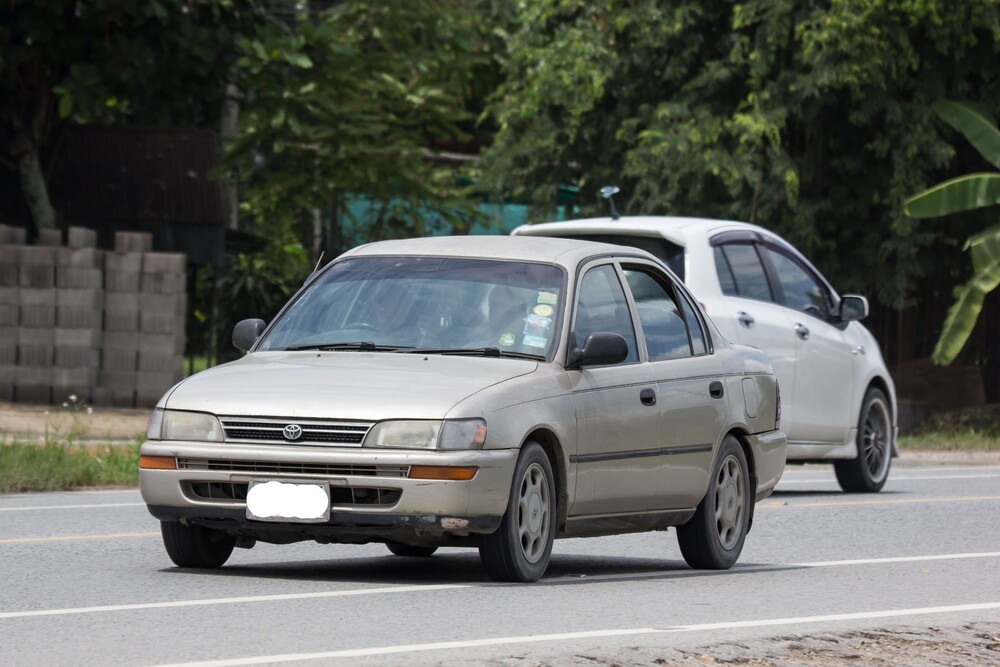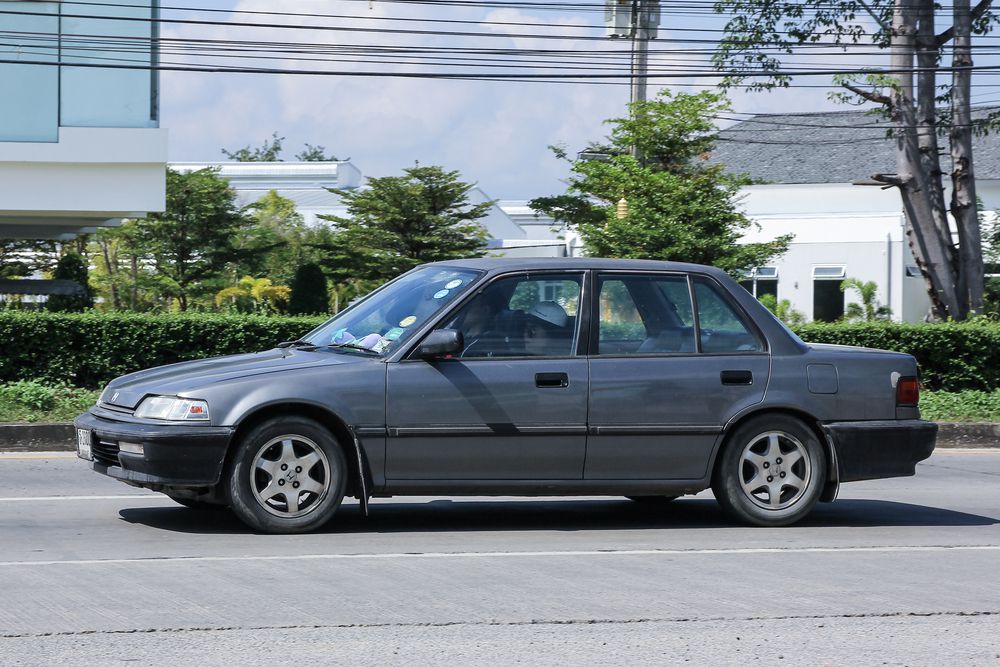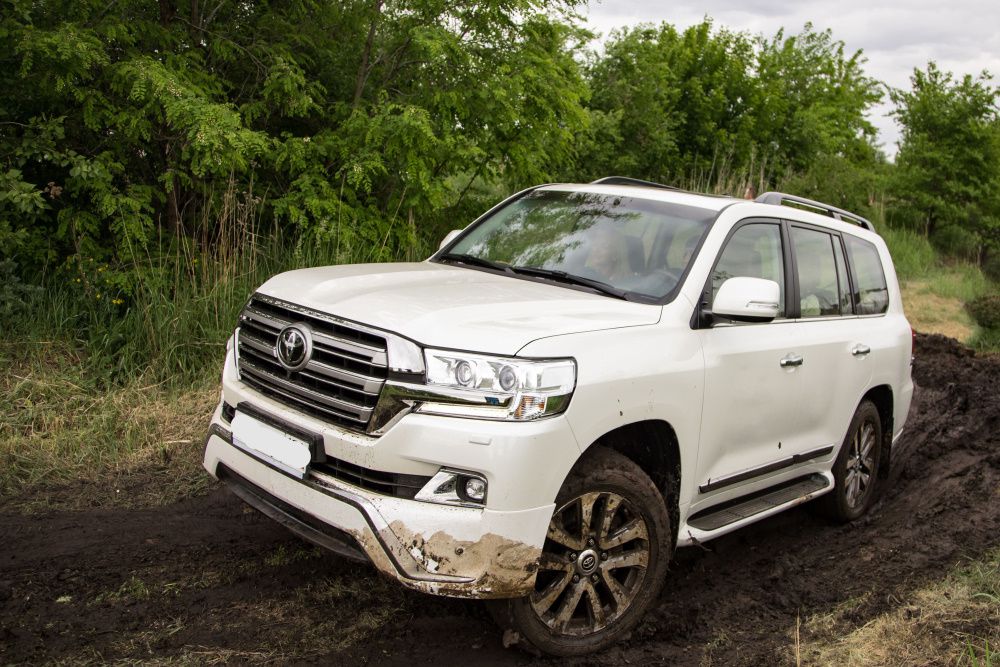Wondering what odometer reading is too high? Depending on the car and model year, it could be anywhere from 50,000 to 300,000.
The average mileage for a car is 10,000 to 12,000 miles a year, so a two-year-old vehicle with 20,000 to 24,000 is considered normal, while a five-year-old vehicle with around 50,000 miles would be about typical. Anything significantly above these numbers is regarded as high mileage, and anything significantly below is low for their model year.
Regardless of the model year, anything over 150,000 miles is usually considered high mileage.
Generally speaking, the lower the mileage, the less wear and tear endured.
Below we'll discuss what to look out for at various high-mileage marks and consider whether age or mileage matters most.
 A high mileage Toyota Corolla still on the road
A high mileage Toyota Corolla still on the road
How Many Miles on a Used Car is Too Much?
According to HeyCar, around 12,000 miles per year (1000 miles per month) is considered average car use.
So, anything beyond that is deemed high mileage — a one-year-old car clocking 20,000 miles, for example.
But, people often use the term "high mileage" to describe cars that have traveled at least 100,000 to over 150,000 miles.
This mileage puts potential purchasers off and is considered "too much" by many people's standards.
Despite that, there is no hard and fast rule for determining how many miles is too much for a car.
Instead, you must consider the vehicle's history to decide whether a specific car's mileage is too high.
Imagine we have two identical cars — one with 40,000 miles and the other with 80,000.
The majority would choose the former.
But what if we told you the 40,000-mile car was a rental car or part of a car-share program, while the 80,000-mile model was independently owned by a single elderly owner and spent most of its life on the highway?
If that didn't change your opinion at first glance, it should.
The rental car has likely spent most of its life in a city or town, constantly using its brakes and
clutch, accumulating its miles over short journeys, driven by people who probably don't care about it.
The owner of the 80,000-mile car has likely looked after it, and thanks to highway driving, its components have had a much easier time.
Suddenly, the higher mileage vehicle seems the most appealing, right?
Hence, we always recommend checking your potential new car's history before treating the odometer reading as gospel.
 A high mileage Honda Accord
A high mileage Honda Accord
So, Is It Okay to Buy Used Cars with High Mileage?
In short, it's okay to buy used cars with high mileage.
But, you need to be mindful of the potential problems — transmission failure, water pump damage, clutch issues, etc. — that may occur and the state of the individual car's maintenance records.
A car's service history will hint at how well the previous owner(s) cared for it.
You also need to be mindful of costly wear parts that need scheduled service, like a timing belt replacement, which is sometimes scheduled for service as low as every 60,000 miles and can easily cost over $1000.
How many miles you plan on putting on the car is also something to think about. Although modern cars can last for many miles, you may not get many more out of the car's already high mileage.
How many owners the vehicle has had is also important. Single-owner vehicles can be preferable even if the car's mileage is high.
Finally, a vehicle history report may be worth purchasing. A vehicle history report is available online and will give you details about the car, like if it has been in any accidents, has been stolen or if it is a salvage vehicle.
Benefits Of A Pre-Purchase Inspection
Regardless of how many miles are on a used vehicle, you should always have a car inspected by an independent mechanic before purchasing.
During a PPI, the mechanic will thoroughly review the entire vehicle and write a comprehensive report on the vehicle's condition, what needs to be fixed on the vehicle, and an estimate on how much the repairs will cost.
 Mechanic performing a pre-purchase inspection
Mechanic performing a pre-purchase inspection
Is 50,000 Miles a Lot for a Used Car?
It depends on the vehicle's age. Ideally, cars should clock around 10,000 miles per year.
Therefore, you can estimate whether 50,000 miles is a lot by multiplying the car's age by 10,000.
For example, a five-year-old car with 50,000 miles or less is optimal, but a two-year-old car with 50,000 miles is a lot.
Regardless, here's a checklist of some things to watch out for on cars that have traveled 50k miles:
Fuel tank cap — The fuel cell cap contains a rubber seal easily damaged over time. At 50,000 miles, the seal often needs replacing or at least a thorough inspection.
Fuel filter — It filters particles and contaminants that shouldn't enter the injector. Generally, it needs replacing on most cars and SUVs running on unleaded gasoline at 50k miles. If you plan to buy a car at this mileage that hasn't had this replaced, remember you'll likely need to pay for it soon after purchase.
Exhaust system — You must inspect everything, including the muffler, manifold, downpipe, catalytic converter, tailpipe, and resonator. Any damage or corrosion should massively impact whether you should purchase the car with 50k miles.
Suspension components — Typically, no replacements to the front-end suspension are needed at the 50,000-mile mark. However, inspecting the CV joints and tie rods gives you peace of mind that everything is in working order (and the car is worth your money).
Tires — Most cars roll off the forecourt with OEM tires, which usually wear out around 50,000 miles. Therefore, make sure they're replaced before deciding to buy the vehicle.
Is 100k Miles Too Much for a Used Car?
Again, the age-to-mileage ratio can help you understand whether 100,000 miles is too much for a specific used car.
Although, age itself can significantly impact the vehicle's general condition and performance.
After all, most modern cars are made to withstand higher mileages — for instance, a 2019 model clocking 100k will probably offer increased longevity than a 2015 model with an odometer reading of 100,000.
Some common problems with buying a used 100,000-mile car are as follows:
No complimentary servicing — Second-hand vehicles with 100k miles or more aren't typically under warranty and exceed their free service mileage limit or timeline. You'll pay out of pocket for any necessary repairs or maintenance.
Heavy wear and tear — This much time spent on the road has undoubtedly put the engine and other components through their paces. It could be risky as cars clocking 100k miles are often past their prime.
Finance restrictions — You'll find it tricky to acquire loans to purchase cars with 100,000 miles as lenders deem it a risky investment.
Should You Buy a Car Over 100k Miles?
Despite the evident cons, buying a car clocking over 100k miles might be worthwhile, depending on your level of risk, personal preference, and budget.
After all, it isn't just doom and gloom — there are plenty of plus points to take advantage of when buying a 100,000-mile car, such as:
Low purchase price — Second-hand vehicles with 100,000 miles on the odometer can massively reduce the ownership cost. Paying cash eliminates a debt, a significant positive in a world with rising living costs.
Decreased depreciation — On average, cars depreciate by 15% to 25% in the first year and as much as 60% over three years. Generally speaking, cars with 100k miles are older, helping you avoid the drastic depreciation.
Cheaper insurance premiums — High-cost vehicles equal larger insurance premiums. The substantial insurance savings are among the best benefits of purchasing a used car clocking 100,000 miles.
 Older high mileage well maintained Ford Truck
Older high mileage well maintained Ford Truck
Is 200,000 Miles on a Car Bad?
Two hundred thousand miles on a car is very high, but that doesn't necessarily mean it's a bad thing.
This odometer reading often marks the end of a car's life expectancy.
But, thanks to technological advancements, proper maintenance may mean your car will live to travel even further.
That said, the further they've driven, the higher the likelihood of excessive wear and tear, so pay particular attention to:
Bubbled and chipped paint — Bubbled paint indicates rust, a probable occurrence with 200k-mile cars. Paint chips, often caused by natural wear from driving thousands of miles, can rapidly lead to rust. Consider the amount of current rust, and figure out how much you're willing to live with.
Squeaky, wobbly suspension — Always take it for a test drive to ensure the car drives straight and doesn't rattle or squeak too much.
Cracked and worn tires — If they are over six years old, they need replacing. Check for sidewall cracks and uneven wear, as tires can be expensive to change if you're on an ultra-tight budget.
Poor engine compression — Bad compression leads to issues with exhaust valves and head gaskets, which are expensive to fix.
Unchanged engine oil — Always establish whether the engine oil is changed regularly. If not, you may want to reconsider.
Interior wear and tear — At 200,000 miles, you can't expect the interior to be stain- or wear-free.
Brake function — When buying a high-mileage car, thoroughly check the brakes. They may have been through a lot, meaning costly replacements in the near future.
Exhaust smoke — Blue smoke equals excessive oil burning, black smoke indicates a fuel problem, and white smoke likely means a head gasket failure.
If you can't see smoke and you're satisfied with the other checks, buying a 200k-mile car might not be a bad idea.
Is 300,000 Miles a Lot on a Car?
Yes, 300,000 miles is a lot on a car. However, newer models with electric engines are built to last until this mark.
Generally speaking, it isn't worth buying a car with 300k miles unless you're a mechanic.
The level of rebuilds and repairs necessary to keep it running isn't worth your time or money — except if it's a classic vehicle.
However, if you're wondering whether your current car will continue until the infamous 300,000-mile mark, the answer is yes.
With a few adjustments to your driving and maintenance regime, you can prolong the life of your vehicle almost effortlessly.
What Type of Mileage is Good for a Used Car?
You can assume the average car owner puts between 10,000 and 12,000 miles on their car each year.
Thus, determining reasonable mileage is simply a case of multiplying its age by 10,000 or 12,000.
But the number alone isn't enough to determine whether you're getting a good deal.
The climate and type of journeys it's taken play a considerable role in the vehicle's condition:
City driving versus highway driving — Cars owned and used in cities, towns, or other built-up areas suffer far more wear and tear than those let loose on the highway. You use the brakes and clutch much more in cities, putting extra strain on the engine and other components. Highway drivers don't use them as often, taking the pressure off the engine and other integral parts.
Gravel versus paved terrain — Vehicles traversing mainly paved terrain are often in better shape than those driving primarily on gravel or rockier tracks and trails. You may discover excessive wear and tear on the car's tires if its previous owner primarily drove around on bumpy or gravel-filled roads.
Colder climates versus warmer climates — Cars kept in colder climates experience much additional wear and tear. From constantly deflated tires to dead batteries to ice in the fuel line, vehicles tend to be in worse shape after enduring winter-esque environments. The biggest thing is that salt on the roads can cause oxidation (rust), leading to all sorts of potential problems and expensive repairs.
The Disadvantages of Buying a Car with High Mileage
Cars with high mileage are often cheaper. Plus, it's the only way to buy a decent discontinued model.
However, many issues may rear their ugly heads, such as:
Costlier maintenance — Low mileage cars are often in better shape. As the odometer reading increases, prepare for more intensive (and expensive) maintenance rituals to offset higher wear and tear levels.
Difficult to acquire car finance — Car mileage and finance plans go hand-in-hand. The higher the mileage, the more hesitant lenders are to offer loans. Thus, you may find yourself stuck with a bad deal.
Miss out on new features — Newer vehicles come with impressive technology, such as high beams, adaptive cruise control, and auto emergency brakes. Contrastly, older, higher-mileage models may lack important safety features.
Reliability problems — Most people rely heavily on their cars to get to work, pick their kids up from school, and head to the grocery store. Unfortunately, breakdowns are more likely with high-mileage vehicles, potentially causing reliability problems when you need it most.
Is Mileage More Important Than Age?
There isn't a winner in the battle between mileage and age — they both matter, as the following table suggests:
Importance Of Mileage And Age Of Used Vehicles
Mileage |
Age |
The cost of use (i.e., the more a vehicle is used, the less it's worth). Some components are built to last longer than others. |
Car depreciation (i.e., the older the vehicle, the less it's worth). |
It isn't an indicator of quality. |
Newer models come packed with technological advancements like improved fuel efficiency, the latest safety features, and lower co2 emissions. |
Highway miles are better than city miles. |
Older cars can rack up mileage on the odometer. |
The higher the mileage, the more you'll need to repair it (typically). |
Daily wear and tear make a long-term impact. |
|
Car parts degrade over time. |
|
The older the car, the more likely it needs repairs. |
|
Older cars with excellent MOT history and regular services have proven reliability.
|
When shopping for a used car, you should never base your decision solely on age or mileage.
To ensure you get the best bang for your buck, you need to look at the age, mileage, the car's overall condition, usage history, and maintenance report.
On top of that, considering the various terrains, it has traversed and how often it tackled difficult ground will help make your mind up.
Which Used Cars Last the Longest?
While a specific used car might sound appealing due to its low price, deeper research may uncover extortionate running costs that cancel out any assumed savings.
Every car is different, and even those with outstanding reputations go wrong sometimes.
Despite that, the following five used cars tend to last the longest:
Honda Accord — Typically, Japanese car manufacturers are a good bet for reliability. You'll hard push you to find complaints about the Accord's maintenance because they are long-lasting and cheap to repair if things run amok.
Lexus LS — This overly engineered vehicle is luxurious, but the maintenance costs are surprisingly low, and it certainly stands the test of time (a journalist got his Lexus LS past 800,000 miles, and it's still running).
Toyota Yaris — Toyota has built a fantastic reputation for crafting long-lasting, reliable cars. Wrap that up in a small, city car package with low insurance costs and excellent fuel economy, and you're on to a winner.
BMW 5 series 1995 to 2003 — While BMW isn't known for its reliability, the 525 variant from this German brand takes genuine effort to break. It's built to take bucketloads of power, and you can often find them for $2,000.
Mazda 6 — The Mazda 6 mixes the Japanese manufacturer's exceptional engineering with Ford's chassis prowess. The result? A used car that handles fantastically and won't break down when you need it most. Plus, there's plenty of room for the kids!
 Historically Toyota Land Cruisers last a long time
Historically Toyota Land Cruisers last a long time
What Brand of Car Lasts the Longest?
According to iSeeCars' report, Toyota is the longest-lasting car brand.
In 2020, 2% of all models sold during the year that reached 200,000 miles were Toyota models.
As for models, the Toyota Land Cruiser, 4Runner, Sequoia, Avalon, Tacoma, and Highlander Hybrid take the top spots.
But don't discount Honda — they're known for building durable, reliable vehicles, and 1.6% of all Honda models sold in 2020 reached 200,000 miles without trouble.
What Is the Most Reliable High-Mileage Car?
Undoubtedly, the Toyota Land Cruiser takes this spot. After all, it does 300,000 miles without batting its metaphorical eye.
This is because it's a Toyota, perhaps the manufacturer with the best reputation for reliability in the world. It is a body-on-frame vehicle, which usually holds up much better than unibody vehicles.
What Is the Best Age to Buy a Used Car?
The five-year mark is normally the best age to buy a used car as the depreciation curve has flattened and reliability versus price is maximized.
However, you still can't determine its overall condition by age alone. Acquire a complex picture to decide whether you're making a good purchase.
Is a 5-Year-Old Car Too Old?
No — this is the perfect time to buy a used car because it's already lost the bulk of its value, meaning you'll pay less and get more. However, five years is when you will usually lose at least part of the vehicle's new car warranty.
What Matters Most When Buying a Used Car?
Aside from age and mileage, a thorough inspection in good weather and daylight is a must when buying a used vehicle, preferably by an experienced mechanic.
Test driving is also essential to ensure it's steering straight, not making funny sounds, and no smoke appears. The test drive should also be performed by a mechanic.
How Does Accrued Mileage Affect Used Car Prices?
Generally, the higher the mileage, the cheaper the used car price due to the assumed increase in repairs and maintenance. There are exceptions; Toyotas and Hondas, for example, will maintain their value relatively well even with high mileage, while brands like FIAT or Renault will lose their value even with lower mileage.
Conclusion
To determine whether a used car has good mileage, multiply its age by 10,000 or 12,000.
But remember, the odometer reading isn't the only thing you should consider when purchasing your next set of wheels!
FAQs
What Is a Good Mileage for a Used Car in Km?
Typically, you should expect issues with a car after 60,000 miles.
But timely and proper maintenance can extend its lifespan.
The better the car has been treated, the more likely it'll carry you for plenty more miles.